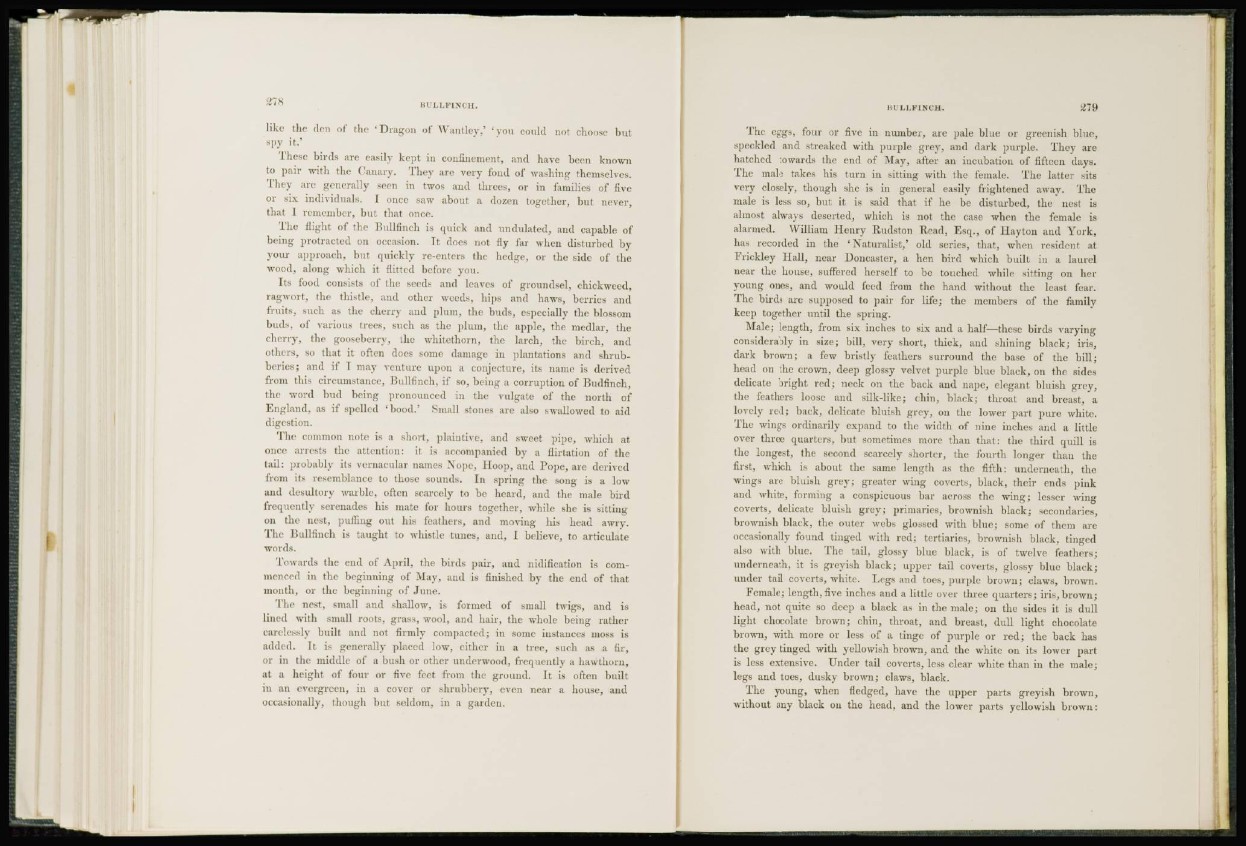
like the den of the 'Dragon of Wantley,' 'you could not choose but
spy it.'
These birds arc easily kept in confinement, and have been known
to pair with the Canary. They are very fond of washing themselves.
They are generally seen in twos and threes, or in families of five
or six individuals. I once saw about a dozen together, but never,
that I remember, but that once.
The flight of the Bullfinch is quick and undulated, and capable of
being protracted on occasion. It does not fly far when disturbed by
your approach, but quickly re-enters the hedge, or the side of the
wood, along which it flitted before you.
Its food consists of the seeds and leaves of groundsel, chickweed,
ragwort, the thistle, and other weeds, hips and haws, berries and
fruits, such as the cherry and plum, the buds, especially the blossom
buds, of various trees, such as the plum, the apple, the medlar, the
cherry, the gooseberry, the whitethorn, the larch, the birch, and
others, so that it often docs some damage in plantations and shrubberies;
and if I may venture upon a conjecture, its name is derived
from this circumstance, Bullfinch, if so, being a corruption of Budfinch,
the word hud being pronounced in the vulgate of the north of
England, as if spelled 'bood.' Small stones are also swallowed to aid
digestion.
The common note is a short, plaintive, and sweet pipe, which at
once arrests the attention: it is accompanied by a flirtation of the
tail: probably its vernacular names Nope, Hoop, and Pope, are derived
from its resemblance to those sounds. In spring the song is a low
and desultory warble, often scarcely to be heard, and the male bird
frequently serenades his mate for hours together, while she is sitting
on the nest, puffing out his feathers, and moving his head awry.
The Bullfinch is taught to whistle tunes, and. I believe, to articulate
words.
Towards the end of April, the birds pair, and nidilication is commenced
in the beginning of May, and is finished by the end of that
mouth, or the beginning of June.
The nest, small and shallow, is formed of small twigs, and is
lined with small roots, grass, wool, and hair, the whole being rather
carelessly built and not firmly compacted; in some instances moss is
added. It is generally placed low, either in a tree, such as a fir,
or in the middle of a bush or other underwood, frequently a hawthorn,
at a height of four or five feet from the ground. It is often built
in an evergreen, in a cover or shrubbery, even near a house, and
occasionally, though but seldom, in a garden.
The eggs, four or five in number, are pale blue or greenish blue,
speckled and streaked with purple grey, and dark purple. They are
hatched towards the end of May, after an incubation of fifteen days.
The male takes his turn in sitting with the female. The latter sits
very closely, though she is in general easily frightened away. The
male is less so, but it is said that if he be disturbed, the nest is
almost always deserted, which is not the case when the female is
alarmed. William Henry Rudston Read, Esq., of Haytou and York,
has recorded in the ' Naturalist,' old series, that, when resident at
Frickley Hall, near Doncaster, a hen bird which built in a laurel
near the house, suffered herself to be touched while sitting on her
young ones, and would feed from the hand without the least fear.
The birds are supposed to pair for life; the members of the family
keep together until the spring.
Male; length, from six inches to six and a half—these birds varying
considerably in size; bill, very short, thick, and shining black; iris,
dark brown; a few bristly feathers surround the base of the bill;
head on the crown, deep glossy velvet purple blue black, on the sides
delicate bright red; neck on the hack and nape, elegant bluish grey,
the feathers loose and silk-like; chin, black; throat and breast, a
lovely red; hack, delicate bluish grey, on the lower part pure white.
The wings ordinarily expand to the width of nine inches and a little
over three quarters, but sometimes more than that: the third quill is
the longest, the second scarcely shorter, the fourth longer than the
first, which is about the same length as the fifth; underneath, the
wings arc bluish grey; greater wing coverts, black, their ends pink
and white, forming a conspicuous bar across the wing; lesser wing
coverts, delicate bluish grey; primaries, brownish black; secondaries,
brownish black, the outer webs glossed with blue; some of them are
occasionally found tinged with red; tertiaries, brownish black, tinged
also with blue. The tail, glossy blue black, is of twelve feathers;
underneath, it is greyish black; upper tail coverts, glossy blue black;
under tail coverts, white. Legs and toes, purple brown; claws, brown.
Female; length,five inches and a little over three quarters; iris,brown;
head, not quite so deep a black as in the male; on the sides it is dull
light chocolate brown; chin, throat, and breast, dull light chocolate
brown, with more or less of a tinge of purple or red; the back has
the grey tinged with yellowish brown, and the white on its lower part
is less extensive. Under tail coverts, less clear white than in the male;
legs and toes, dusky brown; claws, black.
The young, when fledged, have the upper parts greyish brown,
without any black on the head, and the lower parts yellowish brown: